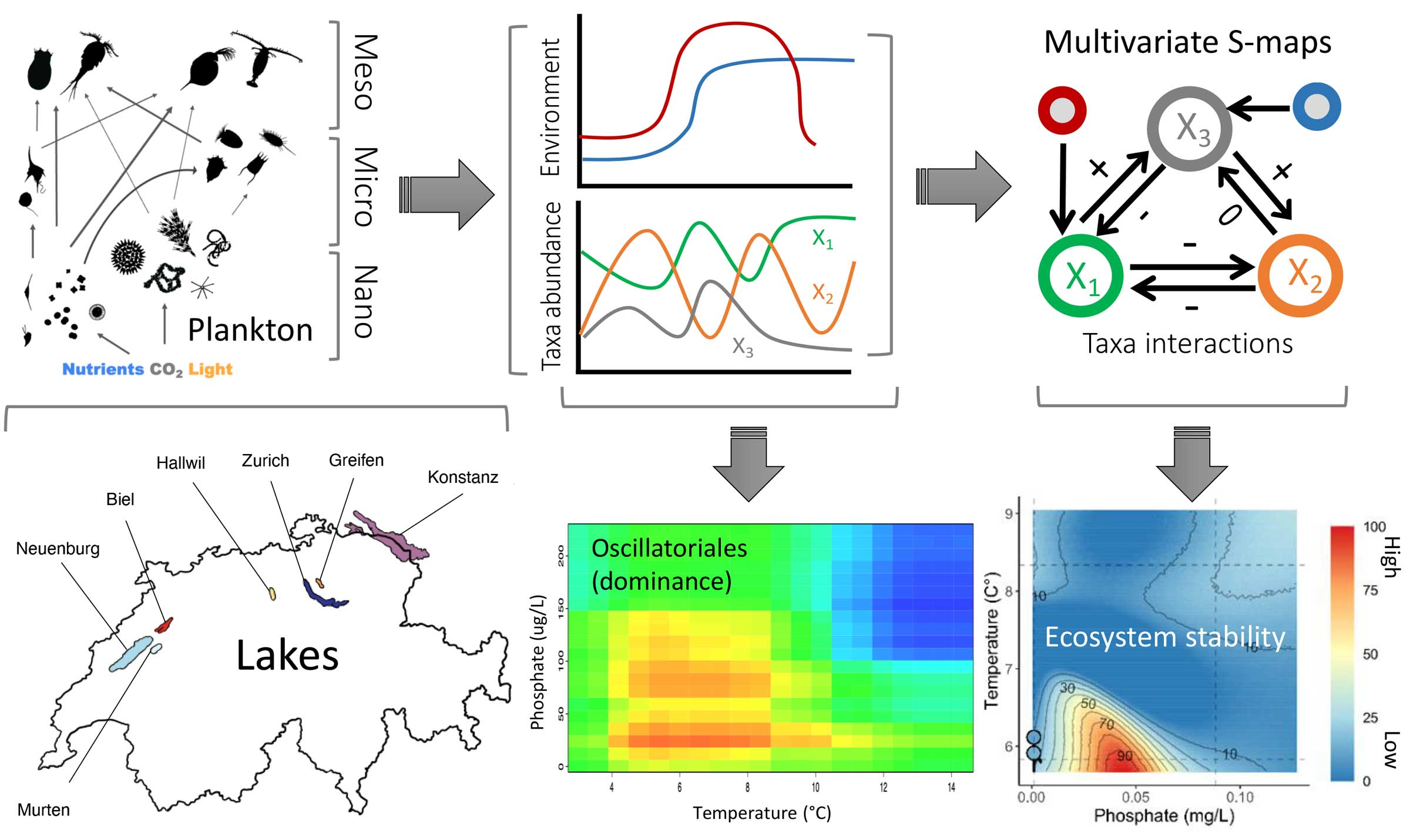How do climate change and nutrient fluctuations interact to affect plankton ecological interactions and ecosystem stability in Lake Constance?
Research approach
Aquatic microorganisms such as algae and zooplankton influence many ecosystem processes such as primary production, fish biomass, water oxygen levels and water quality (Declerck & Senerpont Domis 2023 Hydrobiologia; Elser 1999 Freshwater Biology; Naselli-Flores & Padisák 2023 Hydrobiologia). The ecological interactions (and their temporal stability) among algae, zooplankton, nutrients and temperature are in fact the engine of lake food web functioning and resilience (Bergström & Karlsson 2019 Global Change Biology; Merz et al. 2023 Nature Climate Change). However, these ecological interactions remain mostly unexplored due the lack of data, appropriated analysis methods and the complexity and diversity of lake food webs (Reynolds 2008 International Review of Hydrobiology).
Objectives
In this project we aim to answer these questions:
- How did plankton interactions in Lake Constance change over time, as a consequence of warming, nutrient fluctuations and species invasions?
- How do future projected scenarios of water temperature and nutrient levels jointly influence plankton interactions and ecosystem stability in Lake Constance?

A mosaic of plankton organisms living in Swiss lakes. These organisms are the ones that compose the plankton food web we aim to study in this sub-project.
(Aquascope.ch)
Hypotheses
Relevance
Answering these hypotheses makes the research project highly relevant for public interests, with potential impacts for local conservation and decision making in the context of climate change effects on Lake Constance ecosystem services (e.g. fisheries and water quality). This sub-project is also highly innovative in its scientific disciplines (aquatic ecology, community and food-web ecology, and limnology), by combining data-driven approaches. We will infer lake food-web dynamics, and by producing forecasting models that can assist natural resource management – particularly for an ecosystem providing highly valuable services like Lake Constance.
Methods
To answer the research questions and hypotheses we will model interactions among plankton functional guilds, and between taxa and their abiotic environment (climate change, nutrient levels). To achieve it, we will use time series data of the planktonic food-web (primary producers, herbivores, mixotrophs and carnivores), nutrient loading and water temperature from 10 lakes (including Lake Constance). From these time-series data, we infer i) the time-varying network of taxa interactions and ii) their responses to environmental conditions, using the Empirical Dynamic Model framework (EDM) (Chang et al. 2017 Ecological Research; Munch et al. 2023 Methods in Ecology and Evolution). EDM is the state-of-the-art methodology for data modeling and forecasting in nonlinear dynamic systems such as plankton food webs in lakes (Merz et al. 2023 Nature Climate Change; Kollas et al. 2024 Scientific Reports; Ye et al. 2015 Scientific Reports). Responses of key taxa like the toxic cyanobacterium Planktothrix rubescens to nutrients, temperature and biotic factors will be used to model their dominance as a function of environmental conditions, while properties of the plankton interaction networks will be used to estimate ecosystem stability.

Overview of research work in the sub-project: In this sub-project, monitoring data of the planktonic food-web (primary producers, herbivores, mixotrophs and carnivores) and environmental factors from 7 lakes (including Lake Constance) are used to model interactions among species, and between species and their abiotic environment (climate change, nutrient levels). From time-series data, we infer i) the time-varying network of taxa interactions and ii) their responses to environmental conditions, using EDM (Chang et al. 2017 Ecological Research). Responses of key taxa like the toxic cyanobacterium Planktothrix rubescens to abiotic and biotic factors will be used to model their dominance as a function of environmental conditions, while properties of the plankton interaction networks will be used to estimate ecosystem stability. Collaboration with other project partners (Eawag, University of Konstanz, Kobus and Partner) will allow forecasting changes in the above endpoints under future scenarios of environmental change (nutrient levels, climate warming).
Cooperation within the SeeWandel-Climate project
Phenology of plankton (University of Konstanz, sub-project 3A).
Temperature and nutrients forecast (kup, sub-project 5).
Invasive species (Eawag, sub-project 6C).
Project team
Eawag – Swiss Federal Institute of Aquatic Science and Technology, Department Aquatic Ecology, Switzerland
![]() PD. Dr. Francesco Pomati – Project leader
PD. Dr. Francesco Pomati – Project leader
![]() Dr. Leonardo Capitani – Scientist
Dr. Leonardo Capitani – Scientist
In collaboration with
Prof. Dr. Stephan Munch, U.S. Department of Commerce, National Oceanic and Atmospheric Administration (NOAA), Fisheries, Southwest Fisheries Science Center, U.S.A. & Institute of Marine Sciences, University of California Santa Cruz, U.S.A.
Knowledge exchange modelling
